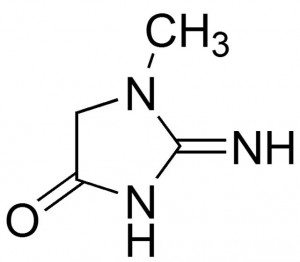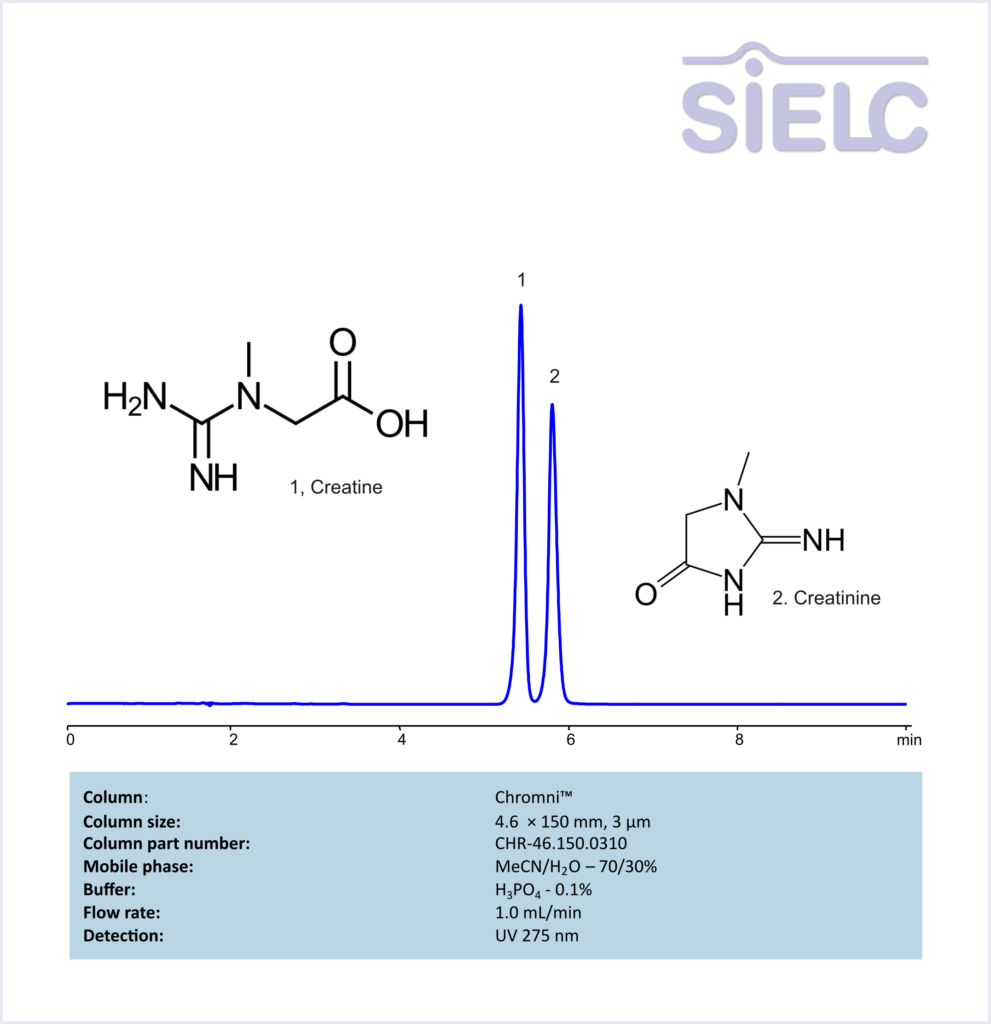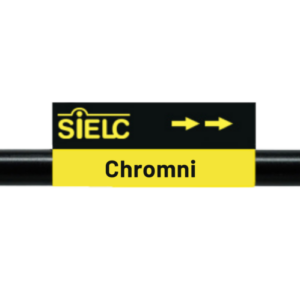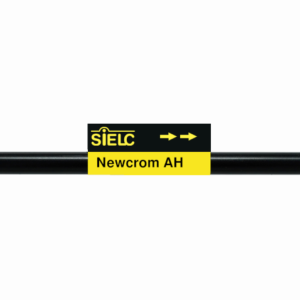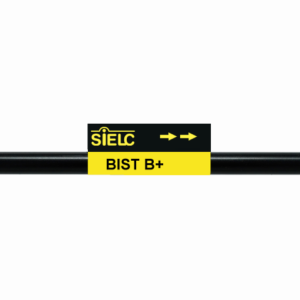| CAS Number | 60-27-5 |
|---|---|
| Molecular Formula | C4H7N3O |
| Molecular Weight | 113.120 |
| InChI Key | DDRJAANPRJIHGJ-UHFFFAOYSA-N |
| LogP | -1.76 |
| Synonyms |
|
Applications:
HPLC Method for Analysis of Creatine and Creatinine on Chromni Column
September 17, 2025
HPLC Method for Creatine, Creatinine on Chromni™ by SIELC Technologies
High Performance Liquid Chromatography (HPLC) Method for Analysis of Creatine, Creatinine
Creatine is a non-protein amino acid-like compound with the molecular formula C4H9N3O2.
Properties:
Appearance: Typically a white odorless powder.
Molecular weight: ~131.13 g/mol
Solubility: Soluble in water.
Uses: Dietary supplement.
Creatinine is a nitrogenous organic compound with the molecular formula C4H7N3O.
Properties:
Appearance: Typically white odorless crystals.
Molecular weight: ~113.12 g/mol
Solubility: Soluble in water.
Uses: Dietary supplement.
Creatine, Creatinine can be retained and analyzed using the Chromni™ stationary phase column. The analysis utilizes an isocratic method with a simple mobile phase consisting of water, acetonitrile (MeCN). Detection is performed using UV.
| Column | Chromni™, 4.6 x 150 mm, 3 µm, 100 A, dual ended |
| Mobile Phase | MeCN – 70% |
| Buffer | Phosphoric Acid |
| Flow Rate | 1.0 ml/min |
| Detection | UV 275 nm |
| Class of Compounds | amino acid |
| Analyzing Compounds | Creatine, Creatinine |
Application Column
Chromni™
Column Diameter: 4.6 mm
Column Length: 150 mm
Particle Size: 3 µm
Pore Size: 100 A
Column options: dual ended
Creatinine

UV-Vis Spectrum of Creatinine
July 11, 2025
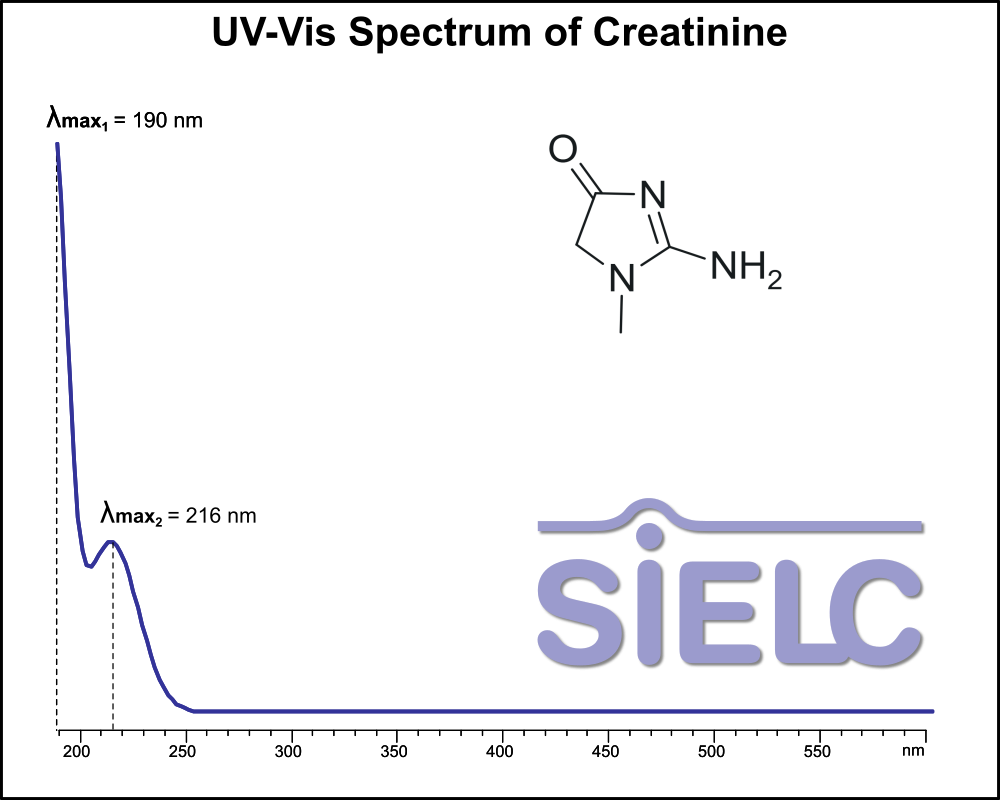
If you are looking for optimized HPLC method to analyze Creatinine check our HPLC Applications library
For optimal results in HPLC analysis, it is recommended to measure absorbance at a wavelength that matches the absorption maximum of the compound(s) being analyzed. The UV spectrum shown can assist in selecting an appropriate wavelength for your analysis. Please note that certain mobile phases and buffers may block wavelengths below 230 nm, rendering absorbance measurement at these wavelengths ineffective. If detection below 230 nm is required, it is recommended to use acetonitrile and water as low UV-transparent mobile phases, with phosphoric acid and its salts, sulfuric acid, and TFA as buffers.
For some compounds, the UV-Vis Spectrum is affected by the pH of the mobile phase. The spectra presented here are measured with an acidic mobile phase that has a pH of 3 or lower.

HPLC Method for Analysis of Creatine and Creatinine in Milk on Newcrom AH Column
May 23, 2025
HPLC Method for Analysis of Creatine, Creatinine on Newcrom AH by SIELC Technologies
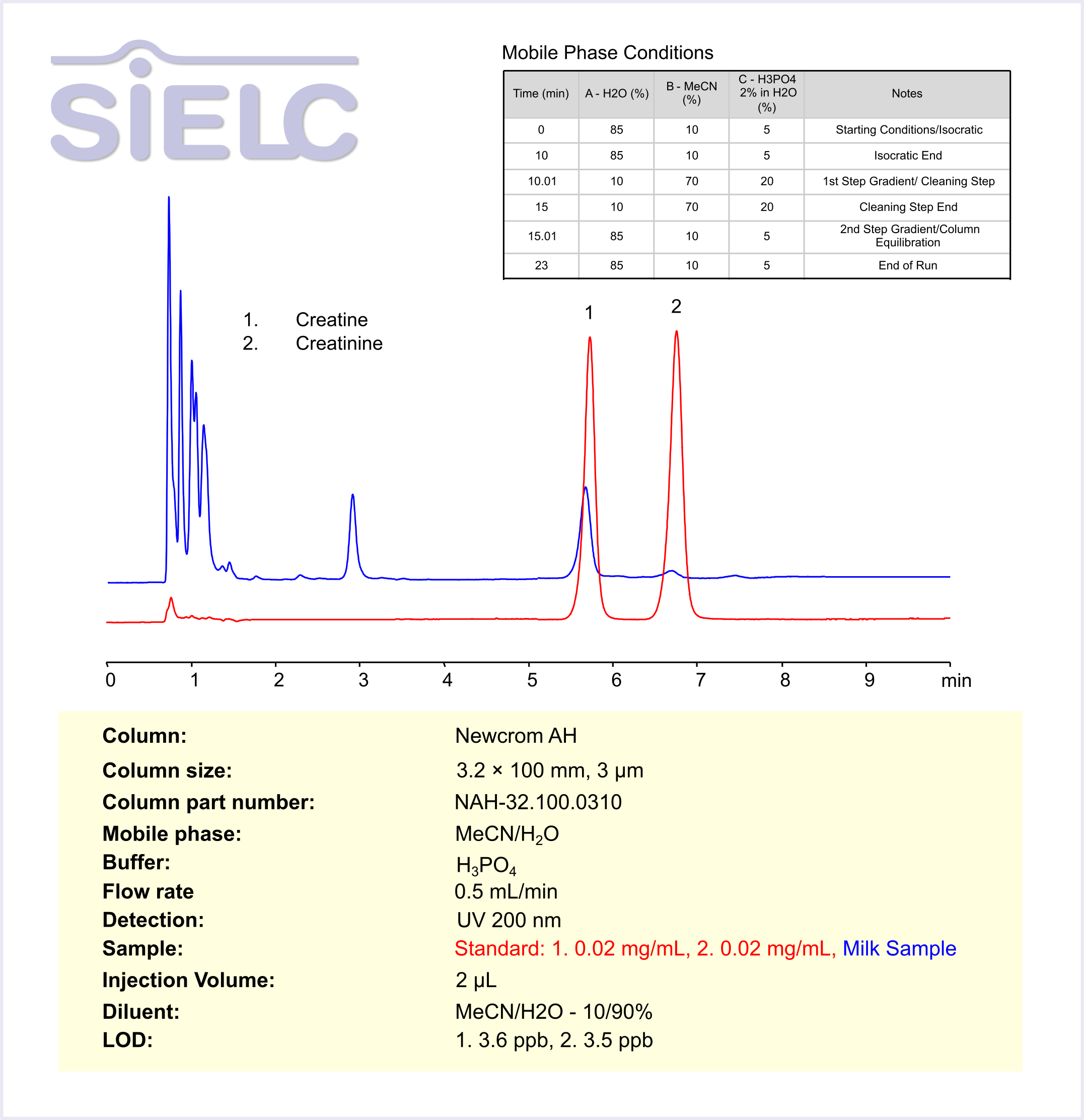
High Performance Liquid Chromatography (HPLC) Method for Analysis of Creatine, Creatinine
Creatine is a naturally occurring compound found in muscles and is used to produce energy during high-intensity exercise. It is synthesized in the body from amino acids and stored in muscles for quick energy release. Creatinine, on the other hand, is a waste product produced from the breakdown of creatine. It is filtered by the kidneys and excreted in urine. The measurement of creatinine levels in the blood and urine is commonly used to assess kidney function, as high levels may indicate impaired kidney function or other health issues. Creatine and creatinine are naturally occurring compounds found in milk, originating from muscle metabolism and dietary sources in lactating animals. While creatine contributes to energy metabolism, creatinine serves as a breakdown product and its levels in milk can be influenced by the animal’s physiological state and kidney function.
Creatine and Creatinine can be analyzed and separated using a Newcrom AH mixed-mode stationary phase column. The analysis utilizes a step gradient method with a simple mobile phase consisting of water, acetonitrile (MeCN), and phosphoric acid as a buffer. Detection is carried out using UV.
| Column | Newcrom AH, 3.2 x 100 mm, 3 µm, 100 A, dual ended |
| Mobile Phase | MeCN/H2O |
| Buffer | H3PO4 |
| Flow Rate | 0.5 ml/min |
| Detection | UV 200 nm |
| Sample | Standard: 1. 0.02 mg/mL, 2. 0.02 mg/mL. Milk Sample |
| Injection volume | 2 µl |
| LOD* | 1. 3.6 ppb, 2. 3.5 ppb |
| Class of Compounds | Amino Acid-Derived compounds |
| Analyzing Compounds | Creatine, Creatinine |
Application Column
Newcrom AH
Column Diameter: 3.2 mm
Column Length: 100 mm
Particle Size: 3 µm
Pore Size: 100 A
Column options: dual ended
Creatinine

HPLC-MS Method for Analysis of Hydroxyproline, Creatine, and Creatinine on Newcrom AH Column
March 6, 2025
HPLC Method for Analysis of Hydroxyproline, Creatine, Creatinine on Newcrom AH by SIELC Technologies
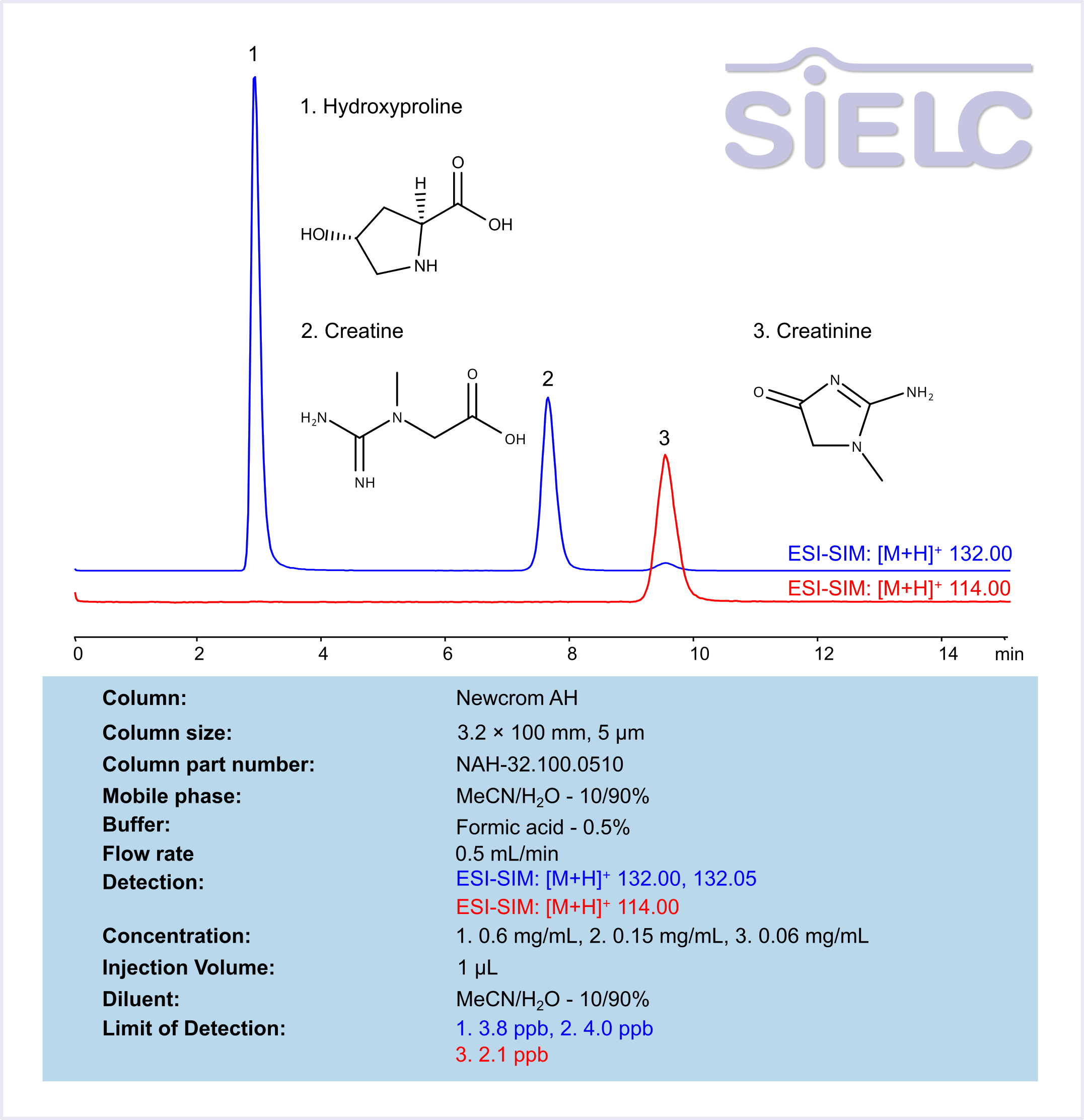
High Performance Liquid Chromatography (HPLC) Method for Analysis of Hydroxyproline, Creatine, Creatinine
Hydroxyproline is a non-essential amino acid primarily found in collagen, the main structural protein in connective tissues such as skin, bones, and cartilage. It plays a crucial role in maintaining collagen stability and is often used as a biomarker for collagen turnover and connective tissue disorders. Creatine is a naturally occurring compound found in muscles and is used to produce energy during high-intensity exercise. It is synthesized in the body from amino acids and stored in muscles for quick energy release. Creatinine, on the other hand, is a waste product produced from the breakdown of creatine. It is filtered by the kidneys and excreted in urine. The measurement of creatinine levels in the blood and urine is commonly used to assess kidney function, as high levels may indicate impaired kidney function or other health issues.
Hydroxyproline, Creatine, and Creatinine can be analyzed and separated using a Newcrom AH mixed-mode stationary phase column. The analysis utilizes an isocratic method with a simple mobile phase consisting of water, acetonitrile (MeCN), and formic acid as a buffer. Mass spectrometric detection was carried out in ESI-SIM mode, monitoring the ions [M+H]⁺ at m/z 132.00, 132.05, 114.00.
| Column | Newcrom AH, 3.2 x 100 mm, 5 µm, 100 A, dual ended |
| Mobile Phase | MeCN/H2O – 10/90% |
| Buffer | Formic Acid – 0.5% |
| Flow Rate | 0.5 ml/min |
| Detection | ESI-SIM: [M+H]⁺ 132.00, 132.05, 114.00 |
| Sample | 1. 0.6 mg/mL, 2. 0.15 mg/mL, 3. 0.06 mg/mL |
| Injection volume | 1 µl |
| LOD* | 1. 3.8 ppb, 2. 4.0 ppb, 3. 2.1 ppb |
| Class of Compounds | Amino Acid-Derived compounds |
| Analyzing Compounds | Hydroxyproline, Creatine, Creatinine |
Application Column
Newcrom AH
Column Diameter: 3.2 mm
Column Length: 100 mm
Particle Size: 5 µm
Pore Size: 100 A
Column options: dual ended
Creatinine
Hydroxyproline

HPLC Method for Analysis of Hydroxyproline, Creatine, and Creatinine on Newcrom AH Column
March 5, 2025
HPLC Method for Analysis of Hydroxyproline, Creatine, Creatinine on Newcrom AH by SIELC Technologies
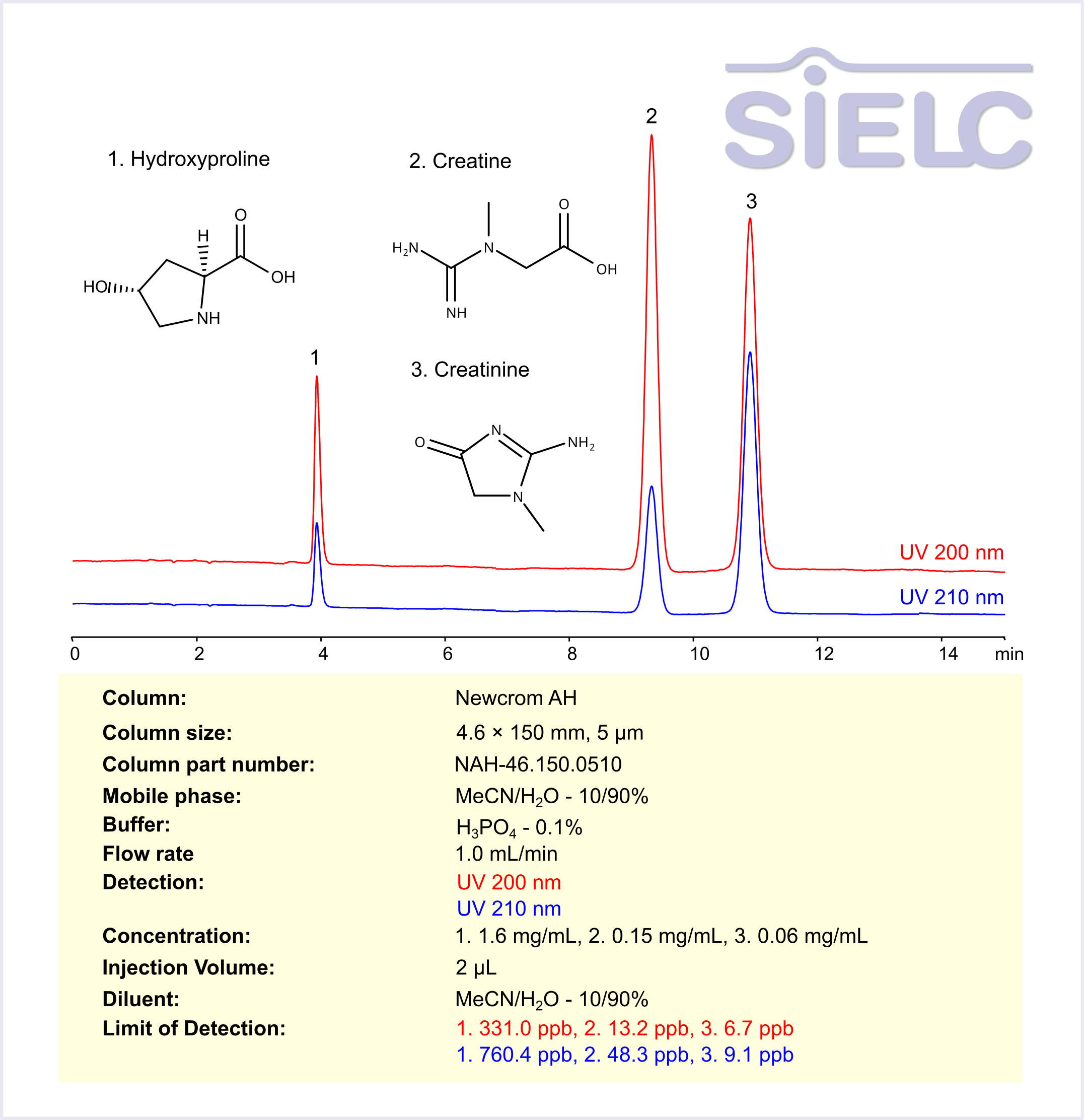
High Performance Liquid Chromatography (HPLC) Method for Analysis of Hydroxyproline, Creatine, Creatinine
Hydroxyproline is a non-essential amino acid primarily found in collagen, the main structural protein in connective tissues such as skin, bones, and cartilage. It plays a crucial role in maintaining collagen stability and is often used as a biomarker for collagen turnover and connective tissue disorders. Creatine is a naturally occurring compound found in muscles and is used to produce energy during high-intensity exercise. It is synthesized in the body from amino acids and stored in muscles for quick energy release. Creatinine, on the other hand, is a waste product produced from the breakdown of creatine. It is filtered by the kidneys and excreted in urine. The measurement of creatinine levels in the blood and urine is commonly used to assess kidney function, as high levels may indicate impaired kidney function or other health issues.
Hydroxyproline, Creatine, and Creatinine can be analyzed and separated using a Newcrom AH mixed-mode stationary phase column. The analysis utilizes an isocratic method with a simple mobile phase consisting of water, acetonitrile (MeCN), and phosphoric acid as a buffer. Detection is carried out using UV.
| Column | Newcrom AH, 4.6 x 150 mm, 5 µm, 100 A, dual ended |
| Mobile Phase | MeCN/H2O – 10/90% |
| Buffer | H3PO4 – 0.1% |
| Flow Rate | 1.0 ml/min |
| Detection | UV 200 nm, 210 nm |
| Sample | 1. 1.6 mg/mL, 2. 0.15 mg/mL, 3. 0.06 mg/mL |
| Injection volume | 2 µl |
| LOD* | 1. 331.0 ppb, 2. 13.2 ppb, 3. 6.7 ppb (UV 200 nm) 1. 760.4 ppb, 2. 48.3 ppb, 3. 9.1 ppb (UV 210 nm) |
| Class of Compounds | Amino Acid-Derived compounds |
| Analyzing Compounds | Hydroxyproline, Creatine, Creatinine |
Application Column
Newcrom AH
Column Diameter: 4.6 mm
Column Length: 150 mm
Particle Size: 5 µm
Pore Size: 100 A
Column options: dual ended
Creatinine
Hydroxyproline

HPLC Method for Analysis of Creatine and Creatinine on Primesep 100 Column
February 26, 2025
HPLC Method for Analysis of Creatine, Creatinine on Primesep 100 by SIELC Technologies
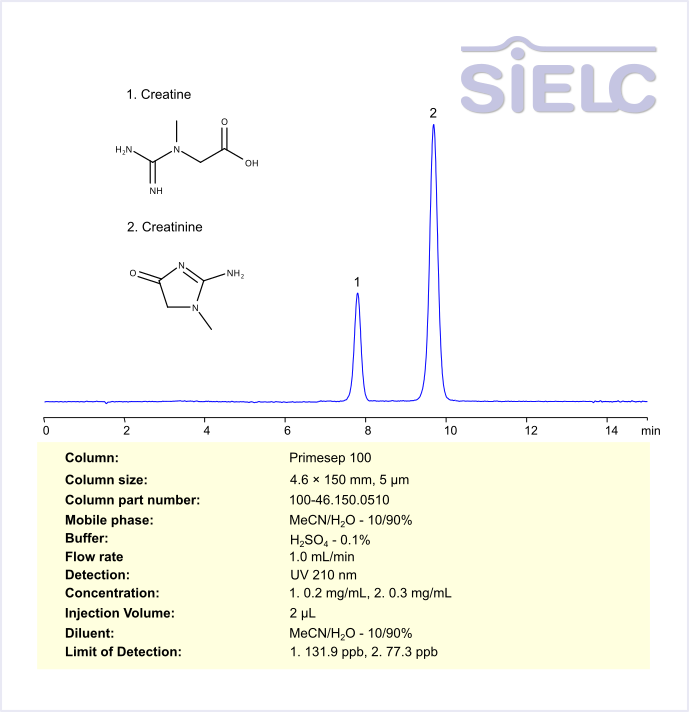
High Performance Liquid Chromatography (HPLC) Method for Analysis of Creatine, Creatinine
Creatine is a naturally occurring compound found in muscles and is used to produce energy during high-intensity exercise. It is synthesized in the body from amino acids and stored in muscles for quick energy release. Creatinine, on the other hand, is a waste product produced from the breakdown of creatine. It is filtered by the kidneys and excreted in urine. The measurement of creatinine levels in the blood and urine is commonly used to assess kidney function, as high levels may indicate impaired kidney function or other health issues.
Creatine and Creatinine can be analyzed and separated using a Primesep 100 mixed-mode stationary phase column. The analysis utilizes an isocratic method with a simple mobile phase consisting of water, acetonitrile (MeCN), and sulfuric acid as a buffer. Detection is carried out using UV.
| Column | Primesep 100, 4.6 x 150 mm, 5 µm, 100 A, dual ended |
| Mobile Phase | MeCN/H2O – 10/90% |
| Buffer | H2SO4 – 0.1% |
| Flow Rate | 1.0 ml/min |
| Detection | UV 210 nm |
| Sample | 1. 0.2 mg/mL, 2. 0.3 mg/mL |
| Injection volume | 2 µl |
| LOD* | 1. 131.9 ppb, 2. 77.3 ppb |
| Class of Compounds | Guanidine Derivatives |
| Analyzing Compounds | Creatine, Creatinine |
Application Column
Primesep 100
Column Diameter: 4.6 mm
Column Length: 150 mm
Particle Size: 5 µm
Pore Size: 100 A
Column options: dual ended
Creatinine

HPLC Method for Analysis of Creatine and Creatinine on Primesep 200 Column
December 10, 2024
HPLC Method for Analysis of Creatine, Creatinine on Primesep 200 by SIELC Technologies
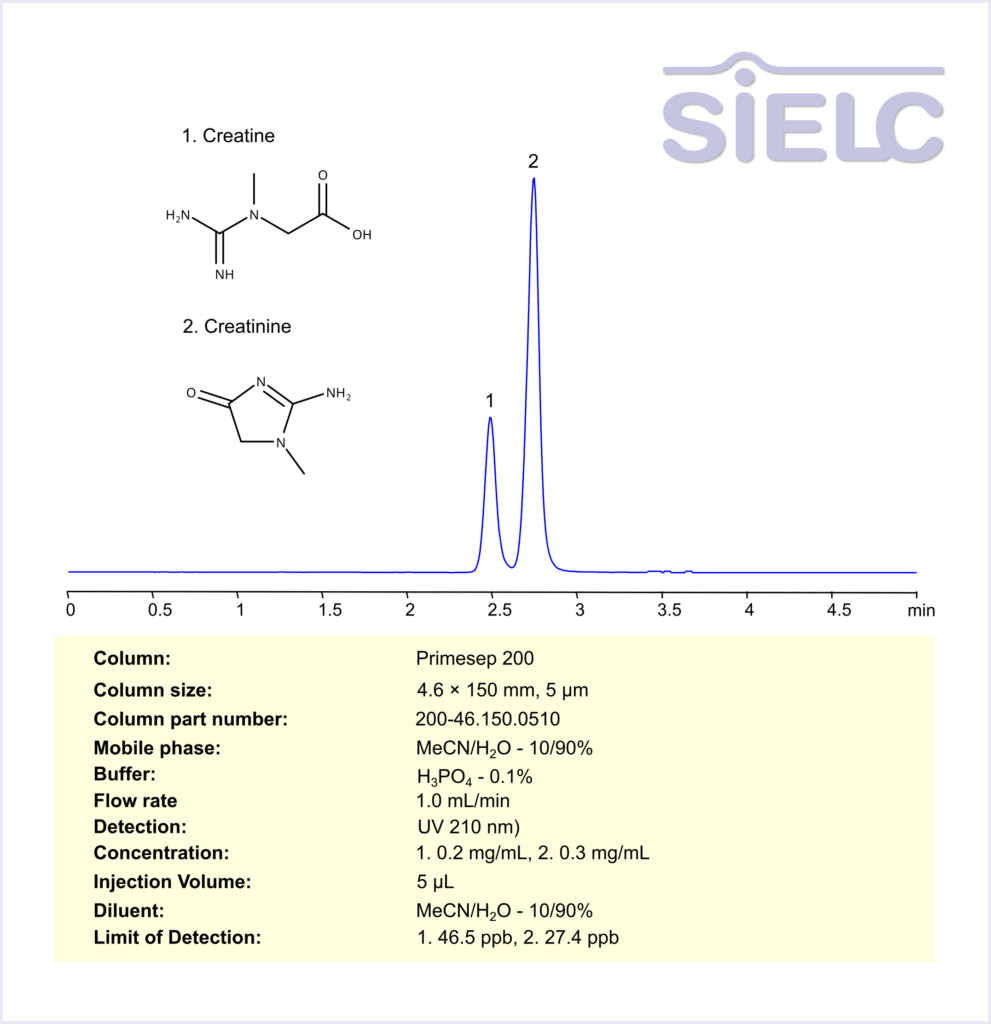
High Performance Liquid Chromatography (HPLC) Method for Analysis of Creatine, Creatinine
Creatine is a naturally occurring compound found in muscles and is used to produce energy during high-intensity exercise. It is synthesized in the body from amino acids and stored in muscles for quick energy release. Creatinine, on the other hand, is a waste product produced from the breakdown of creatine. It is filtered by the kidneys and excreted in urine. The measurement of creatinine levels in the blood and urine is commonly used to assess kidney function, as high levels may indicate impaired kidney function or other health issues.
Creatine and Creatinine can be analyzed and separated using a Primesep 200 mixed-mode stationary phase column. The analysis utilizes an isocratic method with a simple mobile phase consisting of water, acetonitrile (MeCN), and phosphoric acid as a buffer. Detection is carried out using UV.
| Column | Primesep 200, 4.6 x 150 mm, 5 µm, 100 A, dual ended |
| Mobile Phase | MeCN/H2O – 10/90% |
| Buffer | H3PO4 – 0.1% |
| Flow Rate | 1.0 ml/min |
| Detection | UV 210 nm |
| Sample | 1. 0.2 mg/mL, 2. 0.3 mg/mL |
| Injection volume | 5 µl |
| LOD* | 1. 46.5 ppb, 2. 27.4 ppb |
| Class of Compounds | Quaternity amines |
| Analyzing Compounds | Creatine, Creatinine |
Application Column
Primesep 200
Column Diameter: 4.6 mm
Column Length: 150 mm
Particle Size: 5 µm
Pore Size: 100 A
Column options: dual ended
Creatinine

HPLC Method for Analysis of Creatinine on BIST B+ by SIELC Technologies
November 17, 2022
HPLC Method for Analysis of Creatinine on BIST B+ by SIELC Technologies.
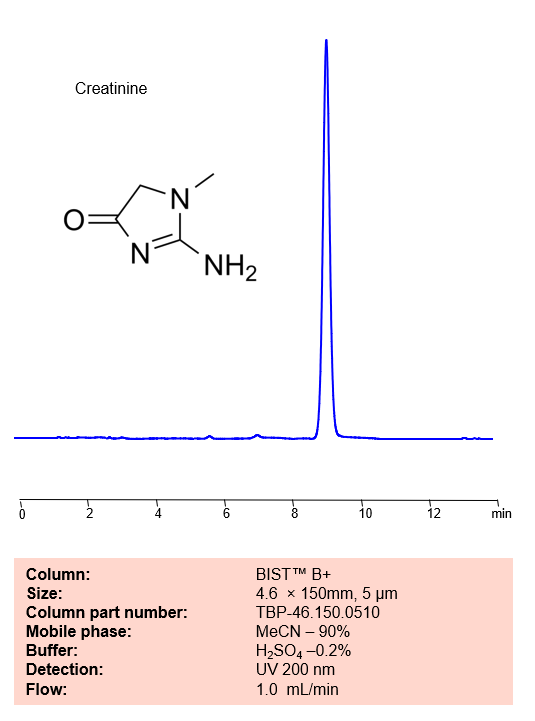
Creatine is a naturally occurring compound found in muscles and is used to produce energy during high-intensity exercise. It is synthesized in the body from amino acids and stored in muscles for quick energy release. You can find detailed UV spectra of Creatinine and information about its various lambda maxima by visiting the following link.
Creatinine can be retained and analyzed using the BIST B+ stationary phase column. The analysis utilizes an isocratic method with a simple mobile phase consisting of water and acetonitrile (MeCN) with a Sulfuric Acid buffer. Detection is performed using UV.
Condition
| Column | BIST B+, 4.6 x 150 mm, 5 µm, 100 A, dual ended |
| Mobile Phase | MeCN – 85% |
| Buffer | H2SO4 – 0.2% |
| Flow Rate | 1.0 ml/min |
| Detection | UV 200 nm |
| Peak Retention Time | 9.09 min |
Description
| Class of Compounds | Xanthines |
| Analyzing Compounds | Creatinine |
Application Column
BIST B+
Column Diameter: 4.6 mm
Column Length: 150 mm
Particle Size: 5 µm
Pore Size: 100 A
Column options: dual ended

HPLC Separation of Neurotransmitters
November 25, 2011
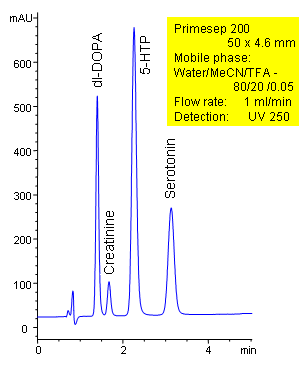
The neurotransmitters dl-DOPA, creatinine, hydroxytryptophan (5-HTP), and serotonin are separated in less than 4 minutes on a short 50 mm Primesep 200 column. The HPLC separation uses a mobile phase of water, acetonitrile (MeCN, ACN) and trifluoroacetic acid (TFA) and UV detection at 250 nm. Ion-pair reagents were not needed for retention of these polar, hydrophilic compounds, instead, a combination of ion-exchange and reversed-phase interactions were used.
| Column | Primesep 200, 4.6×50 mm, 5 µm, 100A |
| Mobile Phase | MeCN/H2O – 80/20% |
| Buffer | TFA – 0.05% |
| Flow Rate | 1.0 ml/min |
| Detection | UV, 250 nm |
| Class of Compounds |
Drug, Acid, Hydrophilic, Ionizable, Hormone |
| Analyzing Compounds | dl-DOPA, Creatinine, Hydroxytryptophan (5-HTP), Serotonin |
Application Column
Primesep 200
The Primesep family of mixed-mode columns offers a wide variety of stationary phases, boasting unprecedented selectivity in the separation of a broad array of chemical compounds across multiple applications. Corresponding Primesep guard columns, available with all stationary phases, do not require holders. SIELC provides a method development service available to all customers. Inquire about our specially-tailored custom LC-phases for specific separations.
Select optionsDOPA (3,4-dihydroxy-L-phenylalanine)
Hydroxytryptophan
Serotonin

HPLC Separation of Creatine, Creatinine and Histidine with MS Conditions
January 13, 2005
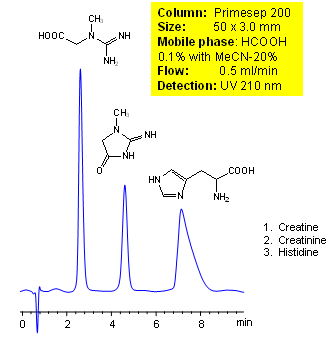
Creatine, creatinine, and histidine are all important amino acids in the human body. All of these can be separated by liquid chromatography. The mobile phase contains acetonitrile (MeCN), water, and phormic acid. Smaller 3 µm particle columns are available for fast UPLC applications. This liquid chromatography method is scalable and can be used for isolation of impurities in preparative separation. It also suitable for pharmacokinetics.
| Column | Primesep 200, 3.0×150 mm, 5 µm, 100A |
| Mobile Phase | MeCN/H2O – 20/80% |
| Buffer | Formic Acid – 0.1% |
| Flow Rate | 0.5 ml/min |
| Detection | UV, 210 nm |
| Class of Compounds |
Drug, Acid, Hydrophilic, Ionizable, Hormone |
| Analyzing Compounds | Creatine, Creatinine, Histidine |
Application Column
Primesep 200
The Primesep family of mixed-mode columns offers a wide variety of stationary phases, boasting unprecedented selectivity in the separation of a broad array of chemical compounds across multiple applications. Corresponding Primesep guard columns, available with all stationary phases, do not require holders. SIELC provides a method development service available to all customers. Inquire about our specially-tailored custom LC-phases for specific separations.
Select optionsCreatinine
Histidine

HPLC Separation of Creatine, Creatinine and Histidine
January 13, 2005
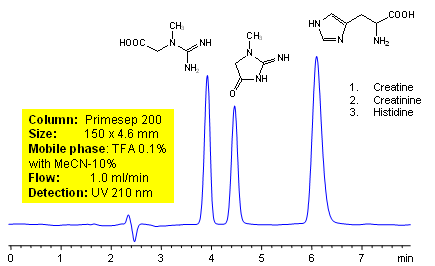
Creatine is produced by the body and plays a major role in recycling ATP. It also stabilizes pH in certain tissues. Creatine can be analyzed by this reverse phase (RP) HPLC method with simple conditions. The mobile phase contains acetonitrile (MeCN), water, and TFA. For Mass-Spec (MS) compatible applications the phosphoric acid needs to be replaced with formic acid. Smaller 3 µm particle columns are available for fast UPLC applications. This liquid chromatography method is scalable and can be used for isolation of impurities in preparative separation. It also suitable for pharmacokinetics.
| Column | Primesep 200, 4.6×150 mm, 5 µm, 100A |
| Mobile Phase | MeCN/H2O – 10/90% |
| Buffer | TFA -0.1% |
| Flow Rate | 1.0 ml/min |
| Detection | UV, 210 nm |
| Class of Compounds |
Drug, Acid, Hydrophilic, Ionizable, Hormone |
| Analyzing Compounds | Creatine, Creatinine, Histidine |
Application Column
Primesep 200
The Primesep family of mixed-mode columns offers a wide variety of stationary phases, boasting unprecedented selectivity in the separation of a broad array of chemical compounds across multiple applications. Corresponding Primesep guard columns, available with all stationary phases, do not require holders. SIELC provides a method development service available to all customers. Inquire about our specially-tailored custom LC-phases for specific separations.
Select optionsCreatinine
Histidine

